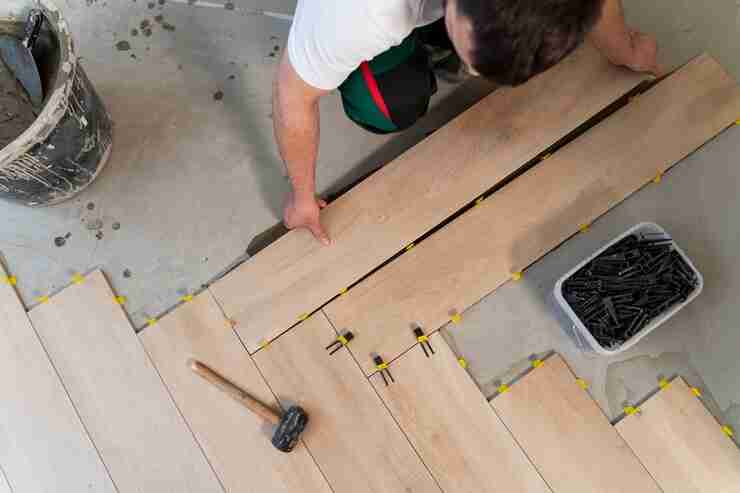
Dreaming of warm, inviting wood floors but don’t want the hassle or expense of ripping out your existing tile? You’re in luck! Installing wood floors over tile is a viable and budget-friendly option that can breathe new life into your space. Here’s everything you need to know about this popular renovation trend.
Is Installing Wood Floors Over Tile Right for You?
Before diving in, it’s important to assess your existing tile floor. Here are some key factors to consider:
- Tile Condition: The tiles themselves should be in good shape, with no cracks, loose tiles, or uneven surfaces. Unevenness can lead to creaking and instability in the new wood floor.
- Grout Lines: Wide grout lines can create an uneven surface for the wood floor. If your grout lines are wider than 1/8 inch, filling them may be necessary.
- Floor Height: Installing wood floors over tile will raise the overall floor height. Ensure doorways and transitions to other flooring types can accommodate this change.
- Subfloor Strength: The subfloor beneath the tile must be strong and secure to support the weight of the new wood floor.
Pro Tip: If you’re unsure about any of these factors, consulting a professional flooring contractor is highly recommended.
Preparing Your Tile Floor for Wood Installation
Once you’ve determined that your tile is suitable for a wood floor overlay, it’s time to prepare the surface!
- Deep Clean: Give your tile a thorough cleaning with a degreaser to remove any dirt, dust, or grime that could hinder adhesion.
- Fix Imperfections: Address any loose tiles, cracks, or uneven grout lines. You can use a grout leveling compound for minor imperfections and a leveling compound for larger dips or bumps.
- Sanding (Optional): While not always necessary, lightly sanding the tile surface with a fine-grit sandpaper can improve the adhesion of the underlayment.
Choosing the Right Underlayment for Installing Wood Floors Over Tile
The underlayment plays a crucial role in the success of installing wood floors over tile. Here’s what to consider:
- Thickness: Opt for an underlayment with a thickness of at least 3/8 inch to address any minor unevenness in the tile and provide a cushioned layer for the wood floor.
- Moisture Barrier: Choose an underlayment with a built-in moisture barrier to protect the wood floor from moisture transmission through the tile.
- Soundproofing: Consider an underlayment with soundproofing properties if noise reduction is a concern, especially in multi-story homes.
Unique Touch: Aaron’s Painting and Remodeling [insert company website link here] offers a special underlayment specifically designed for installing wood floors over tile. This underlayment boasts superior moisture protection, soundproofing capabilities, and a convenient peel-and-stick application for a faster installation process.
Installing Wood Floors Over Tile: Options and Techniques
Now comes the exciting part – installing your new wood floor! Here are the two main methods to consider:
- Glue-Down Method: In this method, the wood floor planks are directly adhered to the tile surface using a strong adhesive. This method offers superior stability and soundproofing but requires a perfectly level subfloor.
- Floating Floor Method: This method utilizes a click-lock system where the wood floor planks interlock with each other, creating a “floating” floor over the underlayment. This method is faster and easier to install but may not be as stable as the glue-down method.
Pro Tip: Regardless of the chosen method, always follow the manufacturer’s instructions for proper installation techniques.
Adding Finishing Touches and Enjoying Your New Wood Floor ✨
Once the wood floor is installed, it’s time to add the finishing touches! This includes:
- Trimming: Install baseboards or shoe molding to cover the expansion gap between the floor and the wall.
- Transitions: Install transition strips at doorways or where the wood floor meets other flooring types to create a smooth and finished look.
Finally, admire your beautiful new wood floor!
Frequently Asked Questions (FAQ) on Installing Wood Floors Over Tile ❓
Q: What type of wood flooring is best for installation over tile?
A: Engineered wood flooring is generally the preferred choice due to its dimensional stability and ability to withstand minor moisture fluctuations.
Q: Can I install laminate flooring over the tile?
A: Yes, laminate flooring is another viable option for installing over tile, provided the tile surface is properly prepared and the underlayment is specifically designed for laminate flooring.
Q: Is it a DIY project, or should I hire a professional?
A: While installing wood floors over tile can be a DIY project for experienced handy homeowners, it requires careful preparation and precise execution. If you’re unsure about your DIY skills or the condition of your subfloor, hiring a professional flooring contractor is highly recommended. They can ensure a smooth, stable, and long-lasting installation.
Q: How long will the new wood floor last when installed over the tile?
A: With proper installation and care, wood floors installed over tile can last for many years. The key factors are choosing the right materials, ensuring a level subfloor, and maintaining a clean and dry environment.